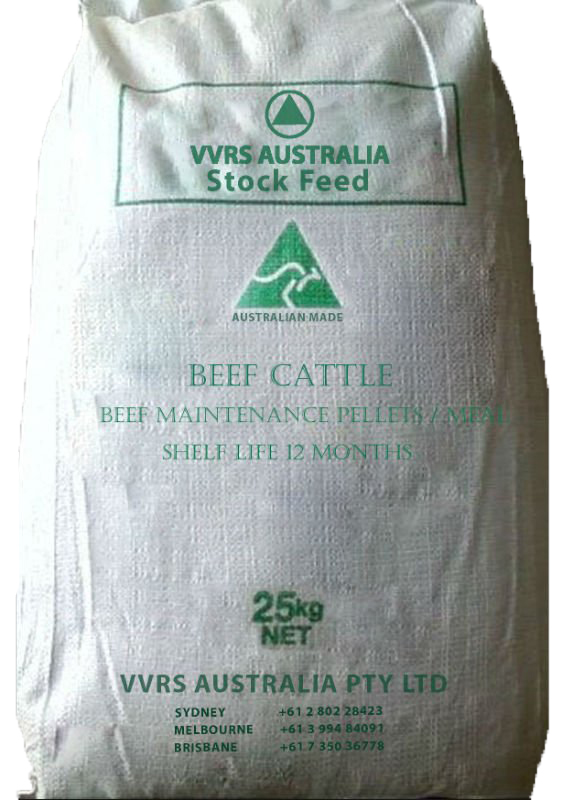BRISBANE: +61 7 350 36778 MELBOURNE : +61 3 994 84091 SYDNEY: +61 2 802 28423

PRODUCT DESCRIPTION
VVRS FEEDLOT PELLETS / MEAL is a high energy feed suitable for the feedlotting of cattle to maximize growth. VVRS FEEDLOT PELLETS / MEAL must be fed in conjunction with a roughage source.
COMPOSITION
• Base grain as depicted seasonally, and therefore the proportions may vary.
• Barley, wheat, maize, sorghum, bran, and pollard, urea, vegetable protein meals, molasses, vegetable oil, limestone, sodium bentonite, dicalcium phosphate, potassium chloride, sodium bicarbonate, salt, monensin sodium, Vvrs ruminant vitamin & mineral premix.
DIRECTIONS FOR USE
• THIS IS NOT A COMPLETE FEED. It has been designed to be fed with hay, silage and/or pasture feeding.
• Roughage should be supplied ad-lib and reducing to a minimum not less than 20% of their total intake.
• It is preferable not to use legume hay or silage when feedlotting cattle. These roughage sources can increase the risk of bloat and may not contain sufficient fibre levels. Grassy or cereal hay or straw would be better.
• Ensure that there is ample access to clean water.
• For grain feeding of cattle the intake of high grain feeds should be gradually introduced to the cattle to allow the rumen to adapt, avoiding acidosis/grain poisoning. Small amounts should be fed at first, slowly increasing over a 3 week period. The following table gives an indication of a suitable introductory period for the cattle.
FEEDING RATES
• VVRS FEEDLOT PELLETS / MEAL may be used as the main feed source (in conjunction with hay, silage or straw) for feedlot cattle as a supplement to pasture when the quality is declining or as a drought supplement to maintain animals.
• NOTE: Feed intakes will vary due to a number of factors. Factors include animal weight, age, body condition, environmental conditions, stocking rates etc.
1. FEEDLOT SITUATION:- Feed intakes in a feedlot will vary, however, cattle will eat approximately 2.5% of body weight in feed per day. Always feed in conjunction with hay, straw or silage.
2. PASTURE SUPPLEMENTATION:- Provided there is adequate roughage in the paddock, cattle may have unlimited access to VVRS FEEDLOT PELLETS / MEAL after the 3 week adaptation period. When using a self-feeder, it is important to place it at sufficient distance from the water source. This will ensure that the pastures are utilised to their full potential. Feed intakes with this system are difficult to predict and may vary from 1% to 2% of body weight.
3. DROUGHT FEEDING:- For maintenance during drought conditions VVRS FEEDLOT PELLETS / MEAL should be fed at approximately 1% of body weight. Feed in conjunction with hay, silage or straw.
TECHNICAL RELEVANCE
• Improvement in performance when compared to using traditional grain feeding.
• Excellent conditional and growth rates.
• Contains vitamins and mineral to provide essential nutrients for growth.
VETERINARY CHEMICALS
This feed contains the following veterinary chemical:
• Monensin sodium at the rate of 25 mg/kg.
MEDICINAL CLAIMM
onensin sodium is added to this feed to improve feed efficiency, weight gain and aid in the control of bloat.
SPECIAL FEATURES
• Palatable mix for finishing cattle on grain.
• Includes rumen buffers and modifiers to enhance performance.
QUALITY PRODUCT
• Manufactured to strict quality control standards.
PRECISE FORMULATION AND MIXING
• Formulated in accordance with current research into ruminant nutrition and mixed using a variety of quality raw materials.
WITHHOLDING PERIOD
Nil.
WARNING
Do not feed to dogs, horses or other equines as it may prove fatal.
STORAGE
Cool, dry conditions away from vermin.
EXPIRY AFTER MANUFACTURE
6 months from the date of manufacture.
PACK SIZE
20kg woven polypropylene bags.Bulk load details available from your sales representative.